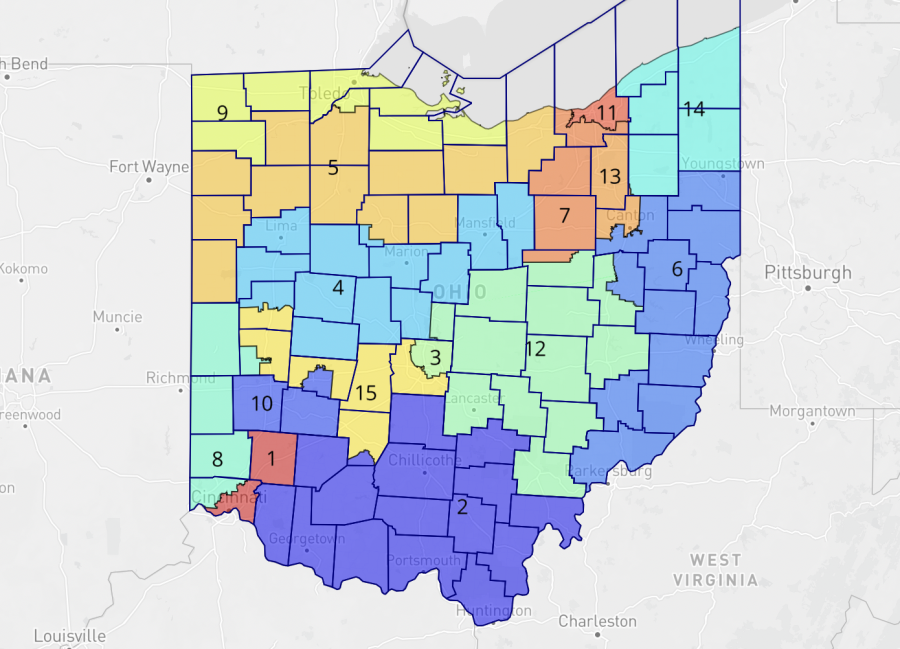Redistricting: We’re Not Done Yet
Nominally, every state is supposed to undergo the redistricting process once a decade, after the release of the decennial census data. The truth is not that simple.
November 12, 2022
After two years of legislative battles, last-minute court decisions, and politics at its most cynical, one would be forgiven if they let out a sigh of relief after all fifty states completed their redistricting process, which redraws districts to fit the most recent census. Some states, such as Arizona, California, Colorado, and Michigan, have nonpartisan redistricting commissions that take the power out of state legislative hands and attempt to enact fair maps. Most, however, are only limited by political reality,such as divided state government, and their own willingness to draw lines that best fit their political desires. In states such as Illinois and Texas, lopsided legislative majorities successfully passed brutal congressional gerrymanders making districts snake across the state to absorb the correct amount of Democratic and Republican voters, to allow them to create lopsided advantages for one party in as many districts as possible. In others, such as North Carolina, Maryland, and New York, gerrymanders were passed only to be struck down by a court decision, forcing fairer maps onto the table. It is these maps, who were given birth by courts, whose ultimate fates are in question, and they may be gone as soon as next year.
Mid-decade redistricting is not particularly common. However, this may be starting to change, as parties become more brutal in their political machinations. One major factor could be to blame: in the modern era, competitive elections for control of the House are common. Vanderbilt Professor of Political Science Bruce Oppenheimer notes that “[having] a House of Representatives… that is narrowly divided, that’s the real incentive.” As Professor Oppenheimer says, in the political landscape before 1994, where Democrats controlled the House nearly all the time, different incentives were created for redistricting. Oppenheimer states that this was the case for incumbents in particular, who would have argued “Why are we trying to make me less safe? You’re not going to win control [of the House].” But with the modern-day House unlikely to produce a permanent partisan majority any time soon, parties are likely to exploit any method they can to squeeze out that extra seat. Two prominent examples of this are in North Carolina and Ohio. North Carolina’s redistricting process was fraught, with Republicans passing a gerrymander that had just four seats won by Joe Biden in the 2020 election, compared to ten seats won by Donald Trump – despite Trump carrying North Carolina by just over one point. This map was eventually overturned by the state’s Democratic-held Supreme Court, which enacted a fairer map in which both Biden and Trump carried seven seats. The Tarheel State’s Supreme Court is elected statewide, and currently has four Democrats to three Republicans, the latter of which have signaled they would support a Republican gerrymander. This year, Republicans flipped two Democratic-held Supreme Court seats, meaning that the state Supreme Court will now consist of five Republicans and two Democrats – making another congressional gerrymander likely. This hypothetical gerrymander could be as strong, if not stronger, than the original map passed by legislative Republicans, and could wipe out three or four Democratic seats.
In Ohio, Republicans’ congressional gerrymander was struck down by the Ohio Supreme Court, which is majority Republican but whose Chief Justice is widely considered to be a moderate. However, unlike North Carolina’s Supreme Court, which took the drawing of the new congressional map into its own hands, Ohio’s Supreme Court tasked the legislature with drawing one that fit the requirements. This allowed Ohio Republicans to simply pass another gerrymander, which got struck down, then another, and another, until they finally ran out the clock and were able to use their congressional gerrymander for the 2022 elections. However, Ohio’s moderate Chief Justice retired this year, and Republicans won her seat with a more conservative candidate, while Democrats failed to flip any seats. This will likely allow Ohio Republicans to pursue an even greater gerrymander than the one they have now, potentially taking another one or two Democratic seats off the board.
There are other, more longshot opportunities for mid-decade redistricting. Lawsuits over New Mexico’s congressional map have made their way to the state Supreme Court, which could potentially strike down the current map, which aims to give Democrats all three seats in the Land of Enchantment. Additionally, the U.S. Supreme Court has been asked to review lawsuits over whether or not states such as Alabama should be forced to draw more Voting Rights Act-protected seats, which would be drawn for minority voters and would likely result in Democrats gaining a seat or two. However, the conservative nature of the Supreme Court makes this unlikely.
On the other hand, the Supreme Court’s conservatism has opened the door to a more radically conservative doctrine: the independent state legislature theory, which asserts that state legislatures, and state legislatures only, have the ability to redraw maps. This is the argument brought forth in Moore v. Harper, a current Supreme Court case. Should the Court rule in favor of independent state legislature theory, maps drawn by courts or independent commissions would be in immediate jeopardy, potentially threatening a wide range of congressional maps. This, however, is an outside scenario.
Ultimately, partisan actors are becoming more brazen, both in the lines they draw and the methods they employ to get there. Vanderbilt students should know this firsthand; Tennessee Republicans carved up Nashville in redistricting, eliminating what had previously been a safe Democratic seat. Tennessee has no legal barriers to this kind of partisan redistricting, and on the federal level, Professor Oppenheimer notes that the seats “probably would have been in violation of the Voting Rights Act… in other words, don’t think it could’ve gotten through preclearance in the old days.” But with that aspect of the Voting Rights Act dismantled by the Supreme Court, Tennessee Republicans feared no federal court backlash. Expect states to continue to try to eliminate competitive seats in favor of seats that favor their intended party by a large margin, ensuring that control of the House comes down to just the handful of districts that remain.
Photo via Dave’s Redistricting.org







